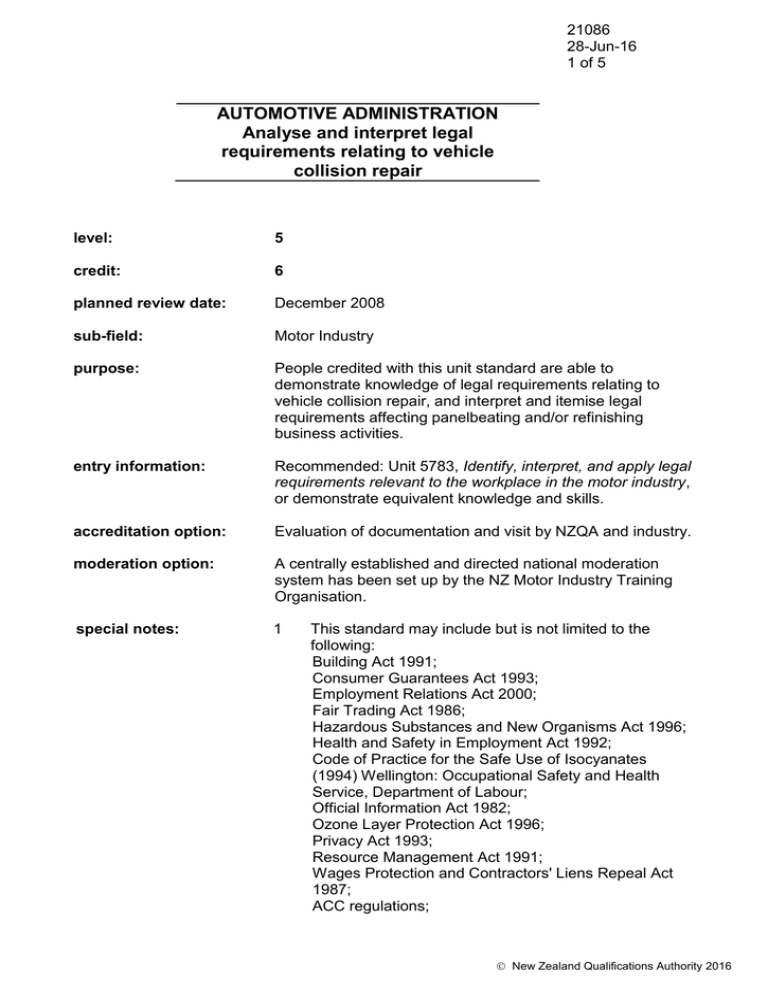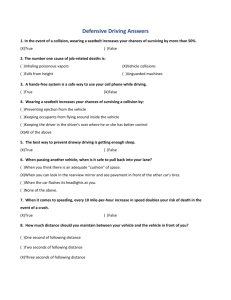AUTOMOTIVE ADMINISTRATION Analyse and interpret legal requirements relating to vehicle collision repair
advertisement

21086 28-Jun-16 1 of 5 AUTOMOTIVE ADMINISTRATION Analyse and interpret legal requirements relating to vehicle collision repair level: 5 credit: 6 planned review date: December 2008 sub-field: Motor Industry purpose: People credited with this unit standard are able to demonstrate knowledge of legal requirements relating to vehicle collision repair, and interpret and itemise legal requirements affecting panelbeating and/or refinishing business activities. entry information: Recommended: Unit 5783, Identify, interpret, and apply legal requirements relevant to the workplace in the motor industry, or demonstrate equivalent knowledge and skills. accreditation option: Evaluation of documentation and visit by NZQA and industry. moderation option: A centrally established and directed national moderation system has been set up by the NZ Motor Industry Training Organisation. special notes: 1 This standard may include but is not limited to the following: Building Act 1991; Consumer Guarantees Act 1993; Employment Relations Act 2000; Fair Trading Act 1986; Hazardous Substances and New Organisms Act 1996; Health and Safety in Employment Act 1992; Code of Practice for the Safe Use of Isocyanates (1994) Wellington: Occupational Safety and Health Service, Department of Labour; Official Information Act 1982; Ozone Layer Protection Act 1996; Privacy Act 1993; Resource Management Act 1991; Wages Protection and Contractors' Liens Repeal Act 1987; ACC regulations; New Zealand Qualifications Authority 2016 21086 28-Jun-16 2 of 5 AUTOMOTIVE ADMINISTRATION Analyse and interpret legal requirements relating to vehicle collision repair Lead Process Regulations 1950; Local body regulations relevant to the motor industry; Spray Coating Regulations 1962; Toxic Substances Regulations 1983; Traffic Regulations 1976; Transport (Vehicle Standards) Regulations 1990; United Nations Economic Commission for Europe (UNECE) vehicle regulations. These regulations are available online at http://www.unece.org/trans/main/welcwp29.htm; Australian Design Rules (ADRs) published by the Department of Transport and Regional Services, Australian Government. Rules can be viewed online at http://www.dotars.gov.au/transreg/str_adrindx.htm; Federal Motor Vehicle Safety Standards (FMVSS) and regulations issued by The National Highway Traffic Safety Administration for the U.S. Department of Transportation. Standards can be viewed online at http://www.nhtsa.dot.gov/cars/rules/import/FMVSS/ Japanese Industrial Standards Committee – road vehicle standards. Information can be sourced from http://www.jisc.go.jp; Land Transport Rules – produced for the Minister of Transport by Land Transport New Zealand. These rules are available online at http://www.landtransport.govt.nz; Land Transport New Zealand Factsheets – available online at http://www.landtransport.govt.nz; Vehicle inspection requirements manual: in-service certification, Land Transport New Zealand. This manual is available online at http://www.landtransport.govt.nz. 2 When the performance criteria state company policy, it is assumed that it is to the same standard as the product and vehicle manufacturers' standards. 3 A specific workplace can be defined as any vehicle collision repair business nominated and recorded for assessment purposes. New Zealand Qualifications Authority 2016 21086 28-Jun-16 3 of 5 AUTOMOTIVE ADMINISTRATION Analyse and interpret legal requirements relating to vehicle collision repair Elements and Performance Criteria element 1 Demonstrate knowledge of legal requirements relating to vehicle collision repair. performance criteria 1.1 Land Transport Safety Rules are explained in terms of how each rule affects the standard of vehicle repairs according to Land Transport New Zealand publications. 1.2 The role of Land Transport New Zealand Factsheets is determined in relation to Land Transport New Zealand’s publications. 1.3 The use of the Land Transport New Zealand’s Vehicle Inspection Requirements Manual: In-service Certification is determined according to Land Transport New Zealand’s publications. Range: 1.4 Vehicle Standards that affect the quality of repairs, replacement of parts, and occupant protection are determined and analysed according to standards body specifications. Range: 1.5 includes but is not limited to – assists repairers achieve correct and consistent standards, statutory requirements for Warrant of Fitness and Certificate of Fitness, applicable legislation details for each requirement. may include but is not limited to – Transport Rules, Transport (Vehicle Standards) Regulations 1990, Australian Design Rules (ADRs), United Nations Economic Commission for Europe (UNECE) vehicle regulations, Federal Motor Vehicle Safety Standards (FMVSS) and Regulations, Japanese Industrial Standards Committee (JIS). Consumer legislation relating to collision repair business is determined and analysed according to the provisions stated in legislation. New Zealand Qualifications Authority 2016 21086 28-Jun-16 4 of 5 AUTOMOTIVE ADMINISTRATION Analyse and interpret legal requirements relating to vehicle collision repair Range: 1.6 The application and ramifications of a repairer’s lien are determined and analysed according to legislation requirements. Range: 1.7 includes but is not limited to – Official Information Act 1982, Privacy Act 1993, Consumer Guarantees Act 1993, Fair Trading Act 1986. may include but is not limited to – holding the vehicle, repair quote, damages in conversion and detinue, claiming compensation through the Disputes Tribunal, selling vehicle at auction. Local body regulations relating to a collision repair business are determined and analysed according to district and local body requirements. Range: includes but is not limited to – resource management, noise, storage, parking, health and safety, environmental procedures. element 2 Interpret and itemise legal requirements affecting panelbeating and/or refinishing business activities. performance criteria 2.1 Legal requirements relating to a specific workplace are interpreted and itemised to check compliance with legislation. Comments on this unit standard Please contact the NZ Motor Industry Training Organisation jlane@mito.org.nz if you wish to suggest changes to the content of this unit standard. Please Note Providers must be accredited by the Qualifications Authority or a delegated interinstitutional body before they can register credits from assessment against unit standards or deliver courses of study leading to that assessment. Industry Training Organisations must be accredited by the Qualifications Authority before they can register credits from assessment against unit standards. New Zealand Qualifications Authority 2016 21086 28-Jun-16 5 of 5 AUTOMOTIVE ADMINISTRATION Analyse and interpret legal requirements relating to vehicle collision repair Accredited providers and Industry Training Organisations assessing against unit standards must engage with the moderation system that applies to those standards. Accreditation requirements and an outline of the moderation system that applies to this standard are outlined in the Accreditation and Moderation Action Plan (AMAP). The AMAP also includes useful information about special requirements for providers wishing to develop education and training programmes, such as minimum qualifications for tutors and assessors, and special resource requirements. This unit standard is covered by AMAP 0014 which can be accessed at http://www.nzqa.govt.nz/site/framework/search.html. New Zealand Qualifications Authority 2016



